Uttarakhand is almost shaded with winter’s snow for half of the year. The terrains of several treks resemble the snowy wonderlands under the glistening sun and offer eye-captivating outlooks of the Himalayas.
Trekking trails have always enchanted me to visit them every once in a while. However, my journey to the mountains took a flight with no awareness and sufficient knowledge about them.
The roads were rocky, slippery, and covered under thick sheets of snow, where I was caught completely unprepared. Trekking and hiking activities require thorough research about the region you’re traveling, a well-planned itinerary, and proper fitness.
Based on my years of experience, planning, and research, I’m here to share a few tips for trekking in winter that you must follow.
Table of Contents
Tips for trekking in winter:
Weather Forecast:
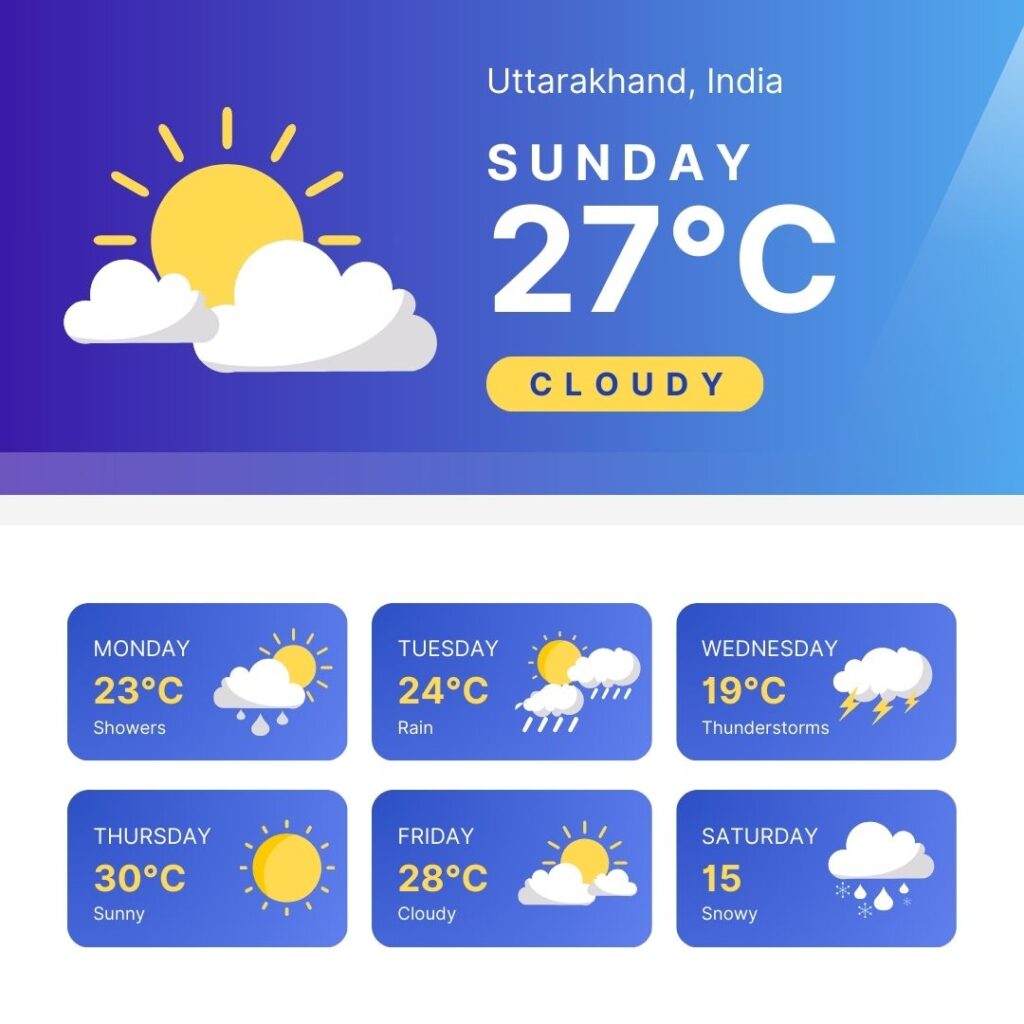
- Before undertaking any trek to the higher altitudes, you must check the weather forecast in advance.
- On reaching your destination and before heading out for the hike, check the avalanche conditions of the area.
- While on your journey, you should plan ahead of the sudden climate change and prepare accordingly, as the weather up there is unpredictable.
Layered Protection:
- Cloth layering is a primary demand for any winter trek.
- It protects your body and maintains the temperature from the chilly winter breeze.
- The trekking is all about moving on foot and it requires your body to have warmth so that it balances the blood circulation.
Here is a guide for a basic layering pattern during a winter trek:
Core Layer:
The core layer is the innermost layer that retains the moisture from entering your body, almost acting as a barrier to safeguard your bones from freezing.
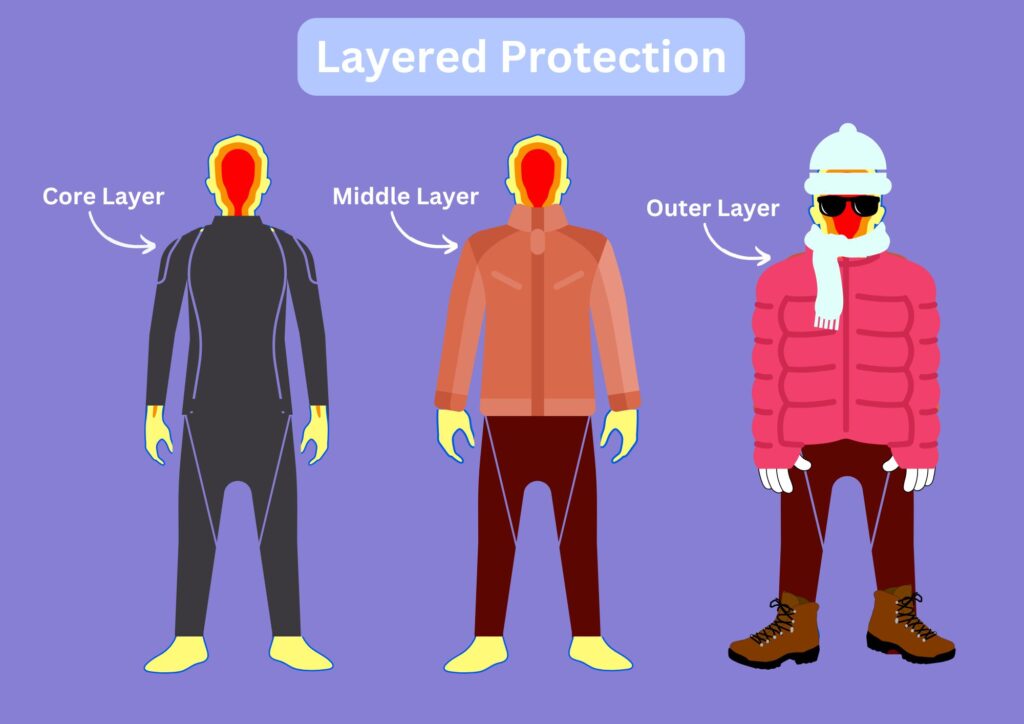
For core layering, you generally wear fitted clothes that hug your body tightly and do not let you feel bulky.
Middle Layer:
The middle layer is particularly worn to provide your body with sustainable warmth and heat to avoid cold-induced damages.
Clothes wrapped around as a middle layer must restrain the freezing air. This basically includes knit sweaters, zipped jackets, etc
Outer Layer:
The outermost layer operates as a shield to ensure protection from sudden climate change, such as intense winds, rain, and snowfall, and thus, they need to be waterproof.
For your outerwear, you should prefer
trench coats, mufflers, tough boots, gloves, etc.
Pre Workout:
- The pre-workout sessions aid you loosen the stiffness of your muscles and bones.
- In order to function better and be adjustable to walk altitudes, your body needs constant push.
- This is the way of enabling your strength to fight the soreness, so it doesn’t result in quick fragility. Besides, you’ll not be falling behind on any turn of the trek.
- Along with physical ability, you must ensure mental wellness.
To make it easier for you we are listing down a few insights on what our HDT team would personally recommend to our fellow trekkers before hikes:
Basic Cardio Exercises:
Cardiovascular exercises help you steady the heart rate when walking on uneven ground and balance the blood pressure as well. They offer the strength and stamina that your body will have a need for while climbing loftier landscapes.
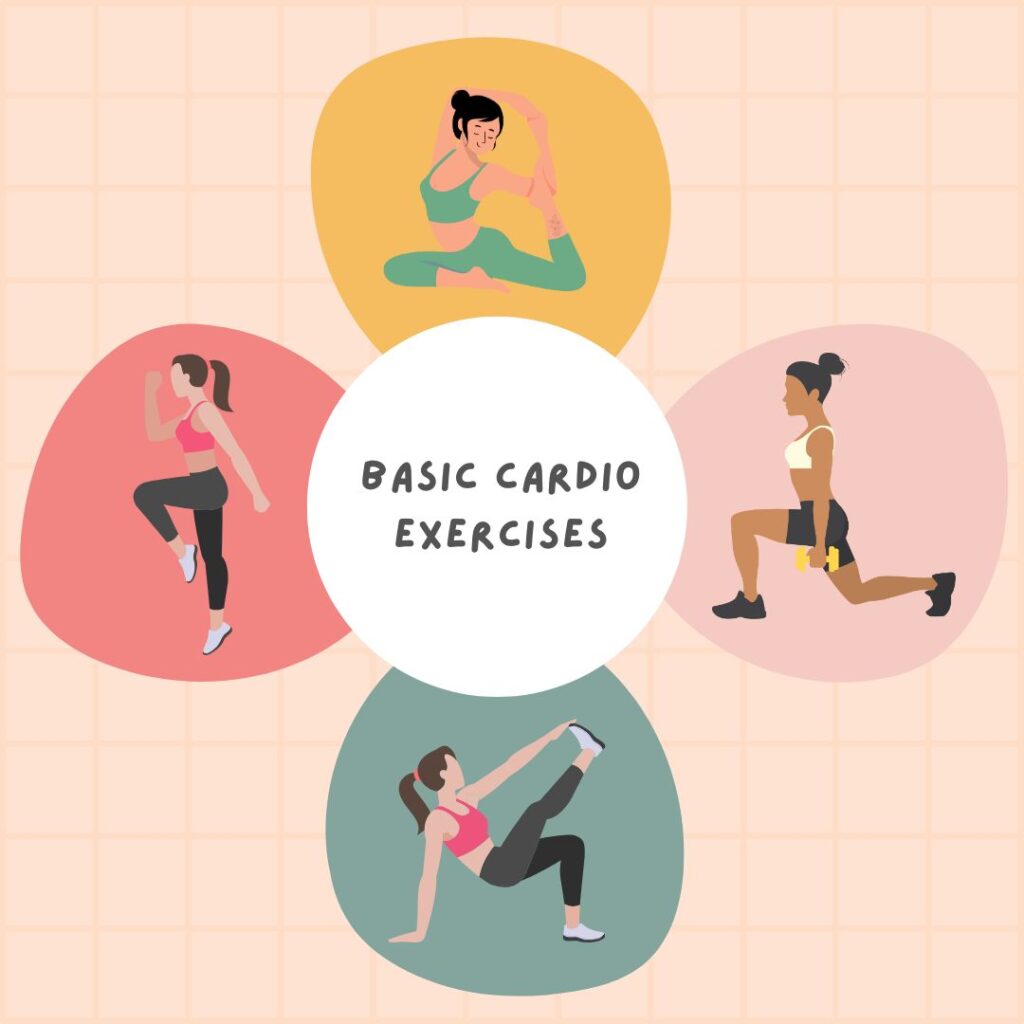
As a beginner, I started with simple exercises like running, cycling, sets up & down, and squats so that they don’t feel overloaded and drain my energy. On getting comfortable with these, I gradually increased my intensity, leveling it with my endurance.
Mountain Climbers:
These are the types of exercises that enable your body to move with sufficient friction from top to bottom. It provides core strength to all muscle groups, including shoulders, arms, knees, back, and legs. Mountain climbers improvise their muscle movement if done in accurate sets.
To perform this exercise, lay down in a plank posture, then bring one knee to your chest and the other behind to maintain the body balance. Then repeat the whole procedure with the other leg and continue with proper rest in between.
Max 30-40 sec for each set.
Calf-rise:
The Calf-rise workout focuses on stabilizing your ankles and calves for long hikes. If you’re so invested in trekking, just like me, you should include this exercise in your daily routine.
These can be done in both sitting and standing positions and are both beneficial. You have to stand by your foot on the floor and stretch your heels as high as you can. This way, it targets the gastrocnemius muscles more.
For seated calf raise, you need to sit over a box, bend your leg at 90°, and then raise your heels till the toes balance the full weight of your feet.
Note: People often utilize dumbbells to perform calf rise as they put more pressure on their soleus and gastrocnemius muscles offering them great mobility.
Meditation & Yoga:
Meditation and Yoga are essential for your holistic fitness. While trekking or hiking, your brain needs to perform logically and to strengthen your thought process; you must indulge in yoga practices.
It keeps your mind fresh with positive affirmations and reduces futile stress. While yoga provides relief to your physical health, meditation soothes your soul and offers peace.
Safety Tools:
Trekking in winter may be a little difficult for many trekkers. In my initial stage of undertaking hikes to such elevations, I hadn’t had any idea about what tools might be helpful during winter.
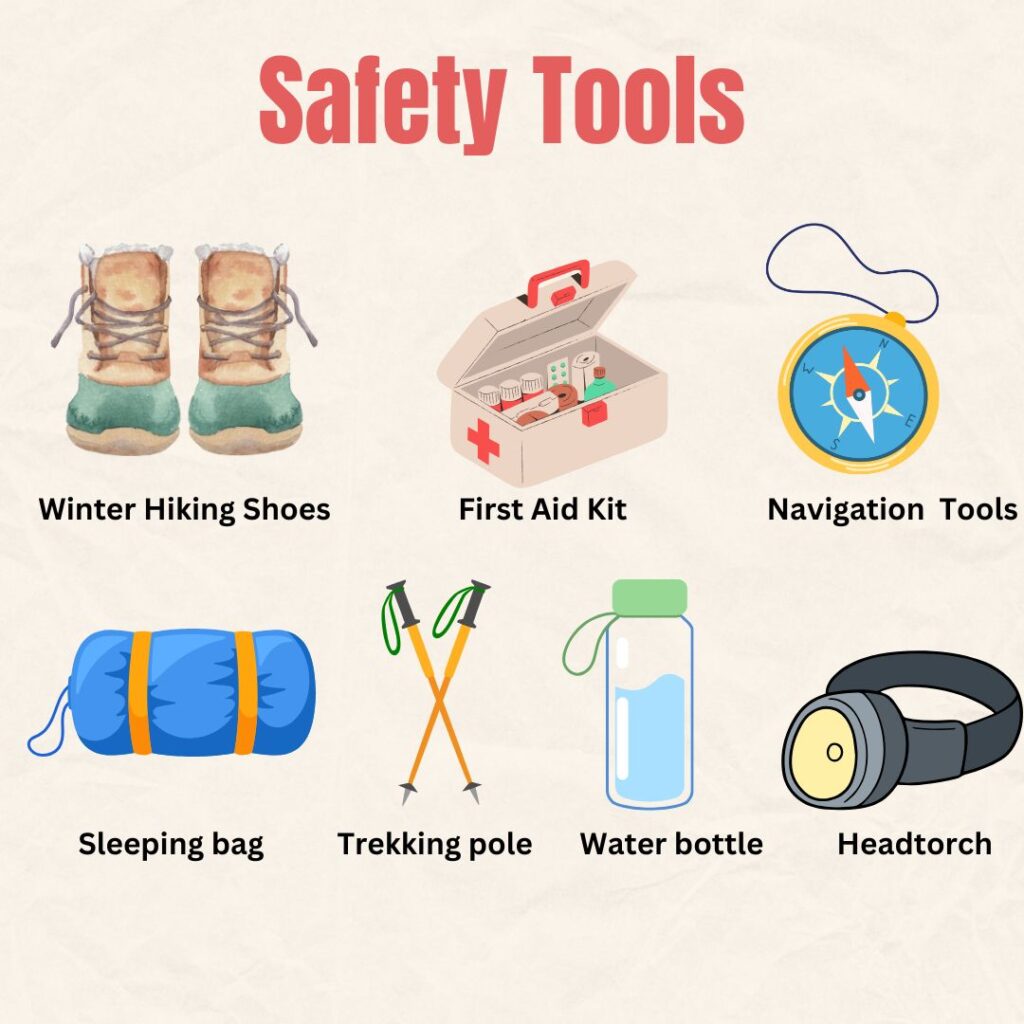
As I moved forward with my passion, I learned about several safety equipment that you must take advantage of, too.
Winter Hiking Shoes:
You must arrange a pair of perfect winter hiking boots that consist of insulation properties to help you warm your feet. They also make you able to walk on a thick blanket of snow on trekking terrains.
While buying winter boots you should consider their material, fit, water-resistance, and traction.
First-Aid kit:
For winter treks, you need to customize a specialized first aid kit with the help of your consultant. If you’re going through some long-term illness, you must carry the prescribed medicines along with you.
Some items that must be packed in your bags while trekking are:
- CPR masks
- Bandages
- Gauze pads
- Thermometer
- Medical tape
- Cold pack
Navigation tools:
Carry navigation tools that will help in choosing the right direction. The most recommended one is the magnetic compass.
Sleeping bag:
While on the treks, your body needs proper rest, and for a peaceful sleep, a sleeping bag is a must. These are lightweight and are easily portable.
For winter treks prefer bags having water-repellent fabric. It provides you with enough warmth and comfort at the highlands.
Trekking pole:
Trekking poles are basic sticks that help in stabilizing your foot movement.
Water bottle:
Pack enough water for the trek because you may face trouble finding water resources up there.
Headtorch:
Headtorch enables you to see your way to your destination and small obstacles in the dark.
Winter essentials:
When you plan to embark on a trekking journey during winter months, there are a few essentials that can not be overlooked for a safe and enjoyable trek.
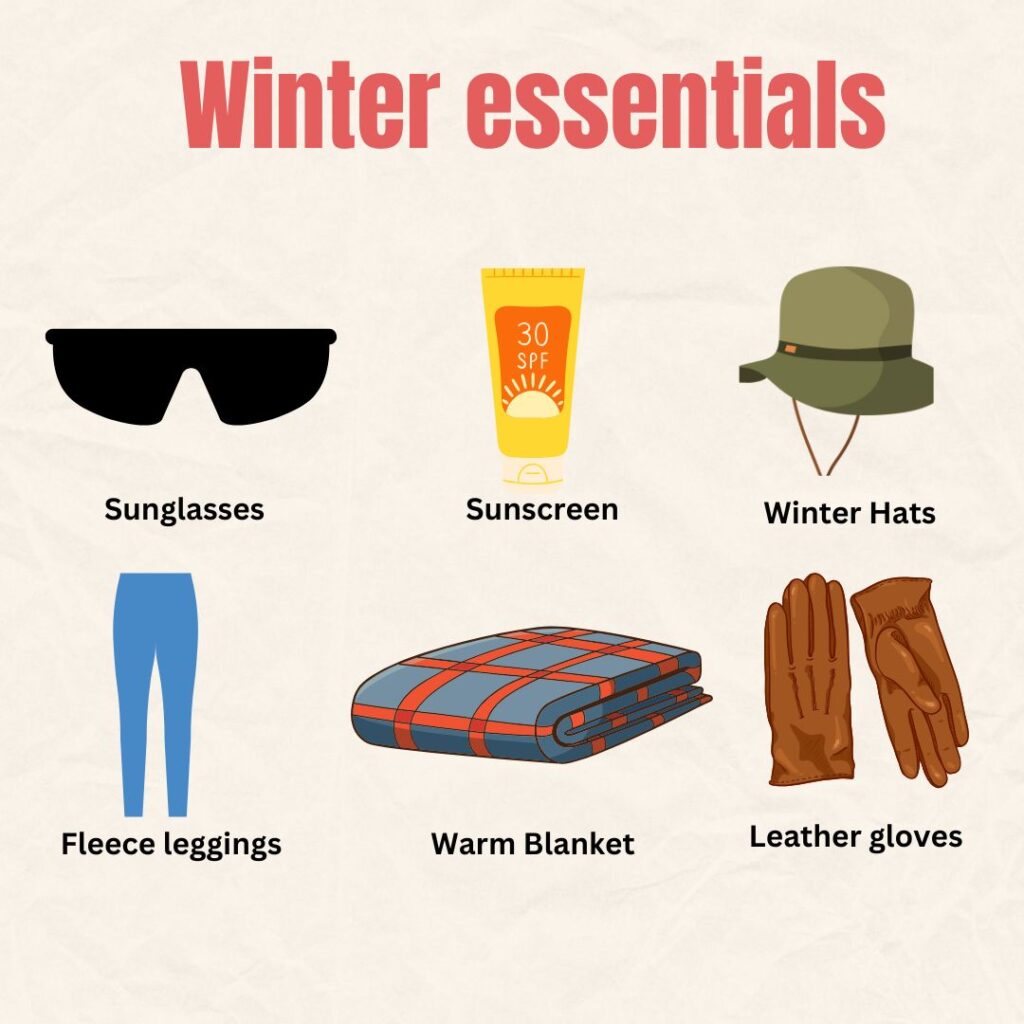
These include items such as:
Sunglasses:
To protect your eyes from harsh sun rays during the day.
Sunscreen:
Apply a broad spectrum 50+ SPF sunscreen as a shield for your exposed skin.
Winter Hats:
Snug-fitted winter hats are for covering your heads, providing them heat in fierce winds.
Fleece leggings:
They cover your legs and offer an extra layer of protection, keeping them warm and insulated.
Warm Blanket:
While sleeping or resting, you may need a warm feeling which you can get by wrapping around a lightweight blanket.
Extra clothes:
Extra clothes offer a sense of security during an emergency. In case, the weather turns drastically, you don’t have to face the shortage of clothes to cover yourself.
Hiking Strategies:
The hiking activities can not be relished well if done in a flash without making any strategies. Moreover, it poses risks as the trails are not always easy to trek, especially in winter.
Here we are mentioning a few things to remember before starting:
- If this is your first time, you must contact any professional or trekking agency for treks that are accessible in winter.
- To start with your trek, you should first select the route to the summit and check its condition.
- Try to travel more during the day as the darkness in the mountains can be proven more risky.
- If you come across sudden calamities, do not hesitate to return to the base point. Your Life is more precious.
- Remember to book your accommodation in advance to avoid last-minute troubles.
- It’s advisable to connect with a travel agency and book your treks as they include a structured itinerary.
Note: Himalayan Dream Treks has been serving in this field for a long time and has built multiple connections across the same field. For a better trekking experience, book your pre-planned package offered by us.
You can contact us through email or our official website.
Hydration:
During winter, you may face some additional challenges and might become a victim of dehydration. To overcome these problems, we advise you to make a schedule for water intake.
Here’s what you can do:
- Drink around 2 liters of water before the trek.
- Carry beverages like electrolyte drinks and tea for breaks.
- You should pack and insulate water filters or bottles as you may not get any drinking facilities in the remote areas.
Note: please avoid the consumption of any type of alcohol-bearing drinks.
Sleeping Pattern:
Due to the gloomy atmosphere in winter the release of melatonin increased and we generally feel sleepy throughout the day.
Where trekking requires activeness, we cannot afford to lose the track of our time, which often happened to me as I felt warmer in the coziness.
To maintain this cycle, I decided to organize a sleeping pattern for myself. However, i don’t want to gatekeeper, let me share it with you all:
- Try to take naps but do not fall for a long sleep during winter treks.
- Ensure that you get the proper dose of sunlight, which helps in suppressing the melatonin.
- Perform exercises to keep your body active.
- Do not get involved in monotonous activities as it would result in heavy feelings and eventually promote sleep.
- Reduce your screen time as it may disturb you sleep
Follow the above rules and maintain consistency in your sleeping schedule before you start with trekking.
Nutritional Intake:
Along with the hydration schedule you’re obliged to have a proper intake of nutrients to meet the demand of the winter treks.
Here’s how my meal look like while going on a trek:
Carbohydrates:
Your diet should enjoy a loading of high-carb foods. Wheat breads, oatmeals, avocados, potatoes and bananas are beneficial for providing sustainable energy to your body.
Fats:
For sufficient warmth and extra calories in your body, you need to consume fat-rich fuels. Here you can include chocolates, nuts, dry fruits, cheese, butter and food that contain adequate oil.
Energy Bars:
These lightweight and nutritional bars help you revive your potential energy. They are essential as they include a mix of fat, proteins, minerals, carbs which helps in building stamina and muscle recovery.
This is a full guide for choosing the best energy bars for trekking: https://himalayandreamtreks.in/blog/5-best-energy-bars-trekkers-should-carry-for-long-treks/
Awareness about Hypothermia and Frostbite:
Hypothermia and Frostbite are common ailments during winters. They can cause great harm to any individual if not taken seriously. Many of us may not even be aware about them and this implies danger.
Let me give you a gist about the both before you commence your journey to the Himalayas.
Hypothermia:
Hypothermia causes your body an intense loss of heat while surrounded by cold weather. The body stops producing the heat or produces comparatively much lower than the actual requirement.
While going through these circumstances, you may feel your body temperature continuously dropping at a rapid rate, you experience shivering, shallow breathing and cold skin.
Frostbite:
This medical emergency indicates the sudden numbness to the minor body parts such as toes, limbs, ears, fingers, chin and nose. It generally happens due to the extreme temperatures around you when the blood freezes and hinders the circulation. You may see your body color changing into pale yellow, blue, red or purple.
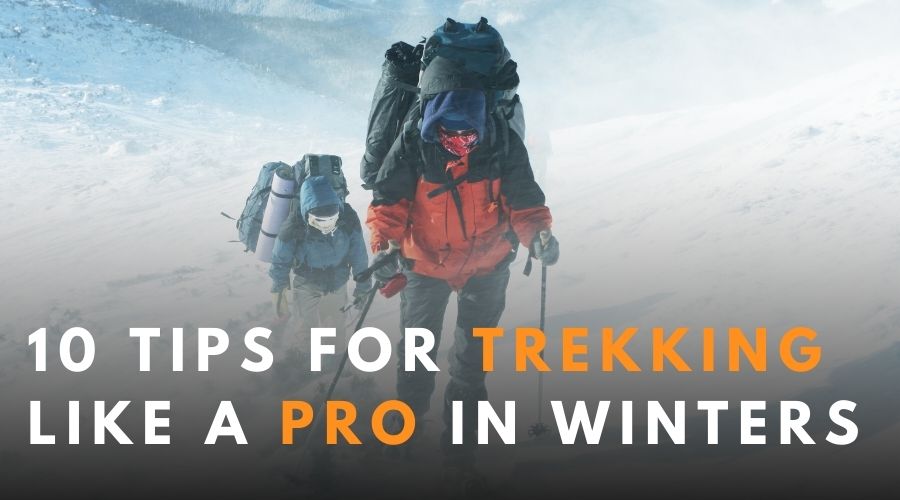
Leave a Comment